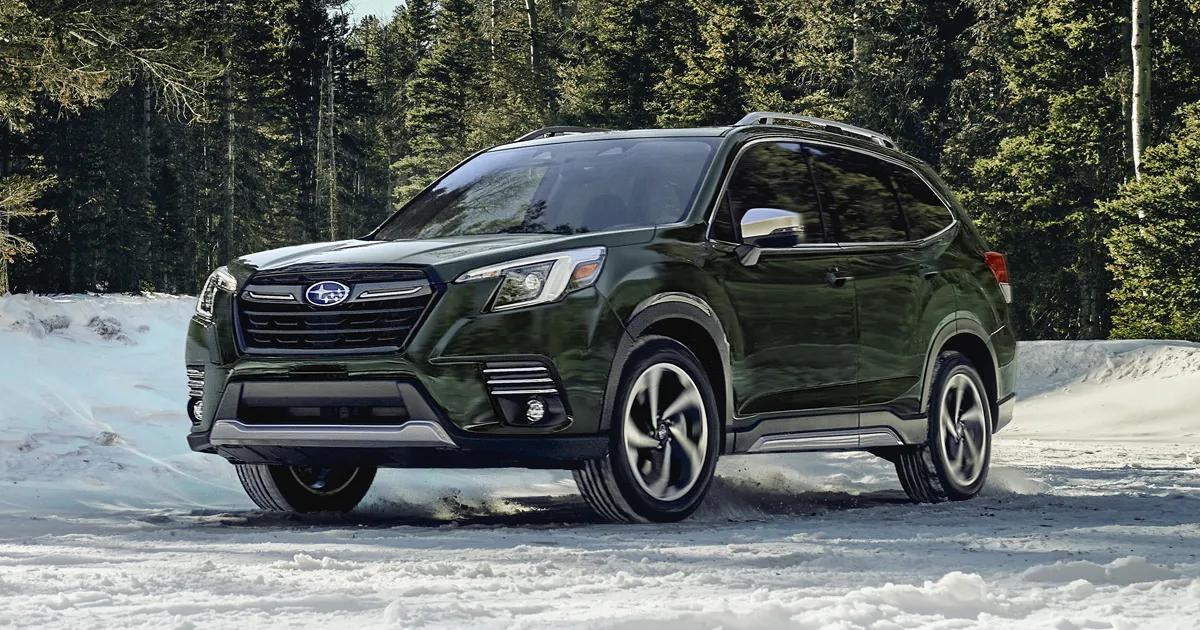Subaru Forester 2023 If You Park Your Vehicle In Case Of An Emergency Base
If you Park Your Vehicle In Case Of An Emergency

The hazard warning flasher should be used in day or night to warn other drivers when you have to park your vehicle under emergency conditions. Avoid stopping on the road. It is best to safely pull off the road if a problem occurs. The hazard warning flasher can be activated regardless of the ignition switch position. Turn on the hazard warning by pushing the hazard warning flasher switch. Turn it off by pushing the switch again. When the hazard warning flasher is flashing, the corresponding turn signal indicator will also flash.
NOTE
When the hazard warning flasher is on, the turn signals do not work.
Maintenance tools
Your vehicle is equipped with the following maintenance tools.
- Jack
- Jack handle
- Screwdriver
- Towing hook (eye bolt)
- Wheel nut wrench
Under the rear floor
The maintenance tools are stored as shown in the following illustrations.
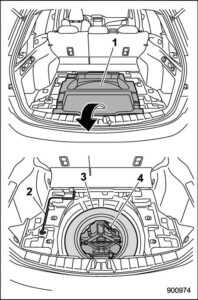
- Under-floor storage compartment (if equipped).
- Jack handle
- Spare tire
- Tool bucket

- Wheel nut wrench
- Screwdriver
- Jack
- Towing hook (eye bolt)
NOTE
- The following items may be different depending on the model.
- The shape of the storage compartment
- The locations of some maintenance tools
Temporary spare tire
- Never tow a trailer when the temporary spare tire is used. The temporary spare tire is not designed to sustain the towing load. Use of the temporary spare tire when towing can result in failure of the spare tire and/or less stability of the vehicle and may lead to an accident.
- When a spare tire is mounted or a wheel rim is replaced without the original pressure sensor/transmitter being transferred, the low tire pressure warning light will illuminate steadily after blinking for approximately one minute. This indicates the tire pressure monitoring system (TPMS) is unable to monitor all four road wheels. Contact your SUBARU dealer as soon as possible for tire and sensor replacement and/or system resetting.
CAUTION
Never use any temporary spare tire other than the original. Using other sizes may result in severe mechanical damage to the drivetrain of your vehicle. The temporary spare tire is smaller and lighter than a conventional tire and is designed for emergency use only. Remove the temporary spare tire and reinstall the conventional tire as soon as possible because the spare tire is designed only for temporary use.
Check the inflation pressure of the temporary spare tire periodically to keep the tire ready for use.
When using the temporary spare tire, note the following.
- Drive with caution when the temporary spare tire is installed. Avoid hard acceleration and braking, or fast cornering, as control of the vehicle may be lost.
- Do not exceed 50 mph (80 km/h).
- Do not put a tire chain on the temporary spare tire. Because of the smaller tire size, a tire chain will not fit properly.
- Do not use two or more temporary spare tires at the same time.
- Do not drive over obstacles. This tire has a smaller diameter, so road clearance is reduced.
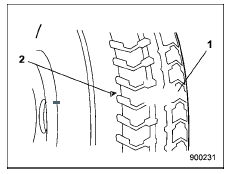
- Tread wear indicator bar
- Indicator location mark
- When the wear indicator appears on the tread, replace the tire.
- The temporary spare tire must be used only on the rear wheel. If a front wheel tire gets punctured, replace the wheel with a rear wheel and install the temporary spare tire in place of the removed rear wheel.
Flat tires
If you have a flat tire while driving, never brake suddenly; keep driving straight ahead while gradually reducing speed. Then slowly pull off the road to a safe place.
Changing a flat tire
- Use only the jack and the jack handle provided with your vehicle. The jack supplied with the vehicle is designed only for changing a tire. Never put any part of your body under the vehicle while the vehicle is being supported by the jack. Doing so could result in serious injury or death.
- Do not jack up the vehicle on an incline or a loose road surface. The jack can come out of the jacking point or sink into the ground and this can result in serious injury or death.
- Before jacking up the vehicle, be sure that there are no occupants or cargo on board.
- Do not jack up the vehicle with an object on or underneath the jack. The jack can be unstable and this can result in a severe accident.
- Always turn off the engine before raising the flat tire off the ground using the jack. Never swing or push the vehicle supported with the jack. The jack can come out of the jacking point due to a jolt and this can result in serious injury or death.
- All passengers must exit the vehicle before you raise it with the jack. Raising the vehicle with someone inside of it could result in serious injury or death.
- Do not start the vehicle while it is supported by the jack. Doing so could result in serious injury or death.
NOTE
Contact a SUBARU dealer when jacking up the vehicle using a garage jack.
CAUTION
Do not hit and bend the disc rotor backing plate when removing and installing the tire. A bent backing plate may scrape against the disc rotor and cause noise while the vehicle is in motion.
- Park on a hard, level surface, whenever possible, then stop the engine.
- Apply the parking brake securely and shift the select lever to the “P” (Park) position.
- Turn on the hazard warning flasher and unload all occupants and luggage from the vehicle.
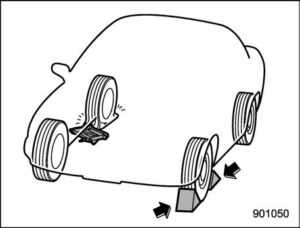
- Put wheel blocks at the front and rear of the tire diagonally opposite the flat tire.
- Take out the jack, jack handle, and wheel nut wrench.
The tools and spare tires are stored under the floor of the cargo area.
NOTE
Make sure that the jack is well lubricated before using it.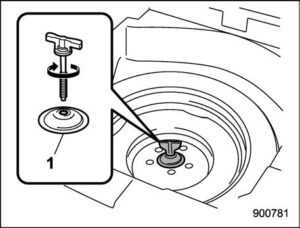
- Take out the tool bucket and turn the attaching bolt counterclockwise, then take the spare tire out.
NOTE
If the spare tire provided in your vehicle is a temporary spare tire, carefully read “Temporary spare tire” and strictly follow the instructions.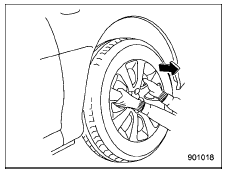
- If your vehicle has wheel covers, after your hands are protected by gloves, grasp the wheel cover spokes and pull toward you to remove the wheel cover.
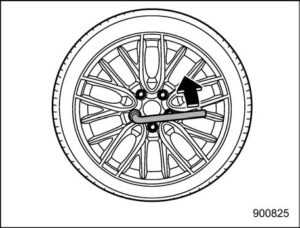
- Loosen the wheel nuts using the wheel nut wrench but do not remove the nuts.
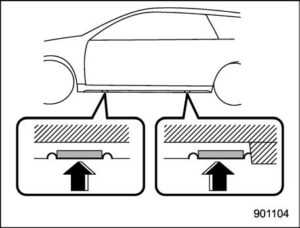 Jack-up points
Jack-up points - Place the jack under the side sill at the front or rear jack-up point closest to the flat tire.
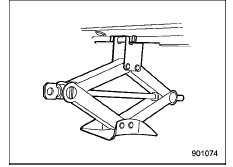 Turn the jackscrew by hand until the jack head engages firmly into the jack-up point.
Turn the jackscrew by hand until the jack head engages firmly into the jack-up point.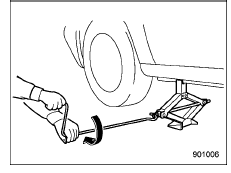
- Insert the jack handle into the jackscrew, and turn the handle until the tire clears the ground. Do not raise the vehicle higher than necessary.
- Remove the wheel nuts and the flat tire.
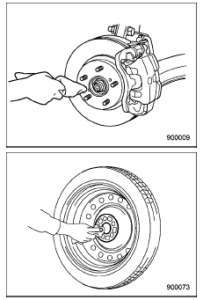
- Before putting the spare tire on, clean the mounting surface of the wheel and hub with a cloth.
CAUTION
If the threaded part is damaged, we recommend that you immediately contact your SUBARU dealer. - Put on the spare tire. Replace the wheel nuts. Tighten them by hand.
WARNING
Do not use oil or grease on the wheel studs or nuts when the spare tire is installed. This could cause the nuts to become loose and lead to an accident. - Turn the jack handle counterclockwise to lower the vehicle.

- Use the wheel nut wrench to securely tighten the wheel nuts to the specified torque, following the tightening order in the illustration. Never use your foot on the wheel nut wrench or a pipe extension on the wrench because you may exceed the specified torque. Have the wheel nut torque checked at the nearest automotive service facility.

- Store the flat tire in the spare tire compartment. Install with the support holder facing upward and secure the flat tire by firmly tightening the attaching bolt.
NOTE
If you cannot fix the flat tire firmly, try turning the support holder upside down. - Store the jack, jack handle, and wheel nut wrench in their storage locations.
WARNING
Never place a tire or tire-changing tools in the passenger compartment after changing wheels. In a sudden stop or collision, loose equipment could strike occupants and cause injury. Store the tire and all tools in the proper place.
Tire pressure monitoring system (TPMS) (U.S.-spec. models)
Low tire pressure warning light
The tire pressure monitoring system provides the driver with the warning message indicated by sending a signal from a sensor that is installed in each wheel when tire pressure is severely low. The tire pressure monitoring system will activate only when the vehicle is driven. Also, this system may not react immediately to a sudden drop in tire pressure (for example, a blow-out caused by running over a sharp object).
WARNING
- If the low tire pressure warning light illuminates while driving, never brake suddenly. Instead, perform the following procedure.
- Keep driving straight ahead while gradually reducing speed.
- Slowly pull off the road to a safe place. Otherwise, an accident involving serious vehicle damage and serious personal injury could occur.
- Check the pressure for all four tires and adjust the pressure to the COLD tire pressure shown on the vehicle placard on the door pillar on the driver’s side.
If this light still illuminates while driving after adjusting the tire pressure, a tire may have significant damage and a fast leak that causes the tire to lose air rapidly. If you have a flat tire, replace it with a spare tire as soon as possible.
- When a spare tire is mounted or a wheel rim is replaced without the original pressure sensor/transmitter being transferred, the low tire pressure warning light will illuminate steadily after blinking for approximately one minute. This indicates the TPMS is unable to monitor all four road wheels. Contact your SUBARU dealer as soon as possible for tire and sensor replacement and/or system resetting.
- When a tire is repaired with liquid sealant, the tire pressure warning valve and transmitter may not operate properly. If a liquid sealant is used, contact your nearest SUBARU dealer or another qualified service shop as soon as possible. Make sure to replace the tire pressure warning valve and transmitter when replacing the tire. You may reuse the wheel if there is no damage to it and if the sealant residue is properly cleaned off.
If the light illuminates steadily after blinking for approximately one minute, promptly contact a SUBARU dealer to have the system inspected.
FAQ
Yes, you can park the Subaru Forester 2023 in case of an emergency or when you need to stop the vehicle for safety reasons.
In an emergency, find a safe location to park the vehicle away from traffic. Activate your hazard lights to alert other drivers, and if necessary, use the parking brake to secure the vehicle.
The general procedure for parking the Forester in an emergency is to find a safe location, activate hazard lights, and apply the parking brake. Additionally, ensure that the vehicle is not obstructing traffic or creating a hazard.
Yes, if you need to park the Forester in an emergency, you can pull over to the side of the road, ensuring that you are not obstructing traffic or posing a danger to yourself or others.
The Forester 2023 does not have a specific emergency parking feature beyond the standard parking brake that can be used in emergency situations.
Yes, if you experience a mechanical failure while driving the Forester, it is important to find a safe location to park the vehicle and address the issue or seek assistance.
When parking the Forester in an emergency, ensure that you are off the roadway and in a safe location. Activate hazard lights, set the parking brake, and use warning triangles or other safety devices if available.
If your emergency situation requires immediate assistance or involves a significant danger, it is advisable to contact emergency services, such as calling the local authorities or emergency hotline.
If you need to leave the Forester unattended after parking in an emergency, it is generally recommended to lock the vehicle and take any valuable belongings with you to ensure their security.
Laws and regulations related to emergency parking may vary depending on your jurisdiction. It is essential to familiarize yourself with the local traffic laws and regulations to ensure compliance.
When parking on a steep incline or decline, you should take extra precautions. Engage the parking brake firmly, turn the front wheels towards the curb (for uphill parking) or away from the curb (for downhill parking), and use wheel chocks if available.
The availability of emergency parking zones or designated areas for emergencies may vary depending on your location. It is advisable to follow local regulations and guidelines regarding emergency parking.
The duration of parking the Forester in an emergency situation depends on the specific circumstances. Once the emergency is resolved or assistance has arrived, you should move the vehicle promptly to avoid obstructing traffic or violating parking regulations.
Useful Link
View Full User Guide: Subaru Forester 2023 Base User Guide
Download Manuals: https://www.subaru.com/owners/vehicle-resources/manuals.html
2023 Subaro Forester Specs, Price, Features, Mileage (Brochure)

